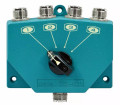 Loading... Please wait...
Loading... Please wait...Shop Categories
Popular Brands
Exclusive Email Deals & Coupons
- Home
- Tuning the Texas BugCatcher
Tuning the Texas BugCatcher
Texas BugCatcher Info and Pricing
The Texas BugCatcher is relatively easy to tune and tuning can be accomplished by anyone with a little patience and experience. PLEASE remember the word PATIENCE especially when tuning on 75 meters.

After assembling and mounting the BugCatcher on the vehicle it is suggested that you first tune for maximum receiver noise at the chosen frequency. This is easily done by slowly moving the coil tap from the top to the bottom of the loading coil, touching each turn of the coil momentarily and listening for maximum signal strength (or noise).
When maximum signal strength is found, attach the tap clip to the coil at that point and then key the transmitter and check for lowest SWR or minimum reflected power. Tuning can usually be more easily accomplished using a reflected power meter instead of a SWR meter. With the transmitter keyed, rotate the VFO back and forth to locate the resonant frequency. (frequency with lowest SWR or reflected power) After determining the resonant frequency in this manner you will know if the antenna needs to be longer or shorter. Use more turns to make the antenna longer and fewer turns to make the antenna shorter.
Move the coil tap up or down the loading coil to fine tune to desired frequency. At this point let's remember that word "PATIENCE" because small movements on the loading coil and winding the tap wire around the loading coil in opposite directions can make a big difference in resonant frequency. We suggest small movements on the loading coil and frequent checks for resonant frequency. It is recommended that tuning be accomplished on 20 or 40 meters first. The higher frequency bands are a little easier to tune and working with them first will help you get the feel of the tuning process.
At times some of the higher frequencies may be difficult to tune on some of the coils. This is due to the large amount of inductance in the unused portion of the loading coil. When this happens we suggest breaking the unused portion of the loading coil into 2 or more sections. For example you may tap for 40 meters first, leave the 40 meter tap wire in place and then tap from that point on up to the higher frequency. This seems to occur most often on the coils with larger amounts of inductance such as the #88 but can also occur on the other 80 meter coils.
You may find the lowest possible SWR (especially on 75 or 40 meters) to be as high as 3:1 or 4:1. Don't be alarmed, this is normal. The feedpoint impedance for a loaded mobile antenna for 75 or 40 meters will be somewhere between 7 and 15 ohms. This will require some type of impedance matching at the feed point. There are several ways to accomplish this and all will work with some degree of success.
The easiest way we have found to handle this matching job is with the "Impedance matching coil". This coil is constructed so it can be easily held in place between the mast and the chosen mount. The matching coil is then tapped to antenna ground with the tap wire provided. By moving this tap up and down it is possible to achieve a perfect match of 1:1. Two or more taps will be required for full phone band operation on 40 and 75 meters. As a rule of thumb the matching coil will require 4 to 5 turns on 75 meters and 3 to 4 turns on 40 meters. 20 thorough 15 meters will require fewer turns and 10 and 12 meters will require little or no matching at all.
Normally only one tap for each band will be required on the matching coil. One tap point per band on the loading coil will usually allow full phone band operation on 10 meters, 12 meters,
 |
Please observe the following rules to insure maximum performance and life from your Texas BugCatcher.
1. We strongly recommend supporting the Texas BugCatcher as high up the mast as possible because of weight and wind loading. 2. Because of water shorting between turns of the coil DO NOT transmit using more than 100 watts output when operating in rain or drizzle. This problem can be reduced when coil is tapped from the top down as shown in the drawing. 3. DO NOT transmit at any power level if coil is iced over. 4. We CAN NOT be responsible for corona arcing due to power level being excessively high in relation to the mechanical size of the antenna With normal care the Texas BugCatcher will give many years of excellant service when the above suggestions are followed |
Texas BugCatcher Info and Pricing





 All prices are in
All prices are in